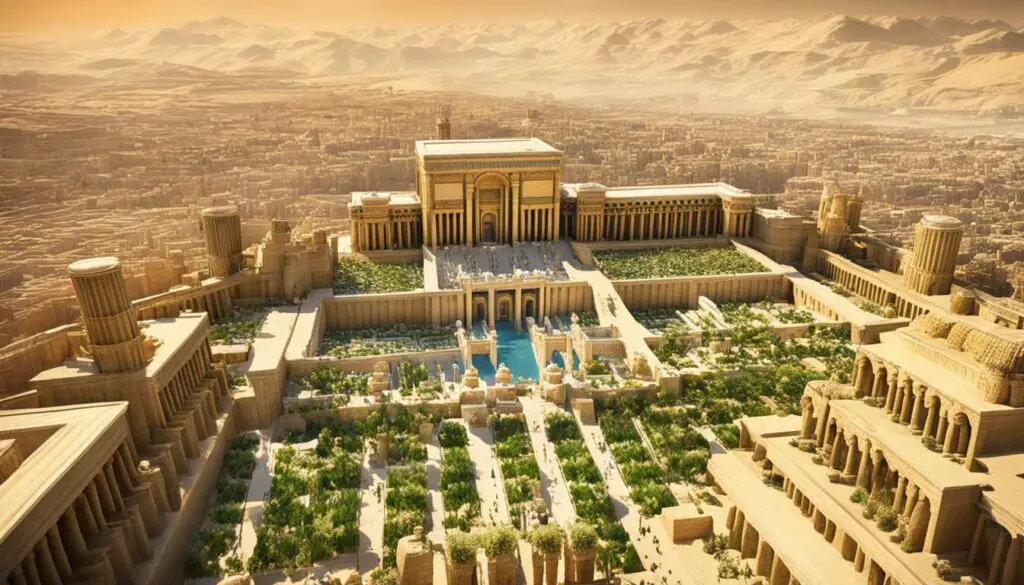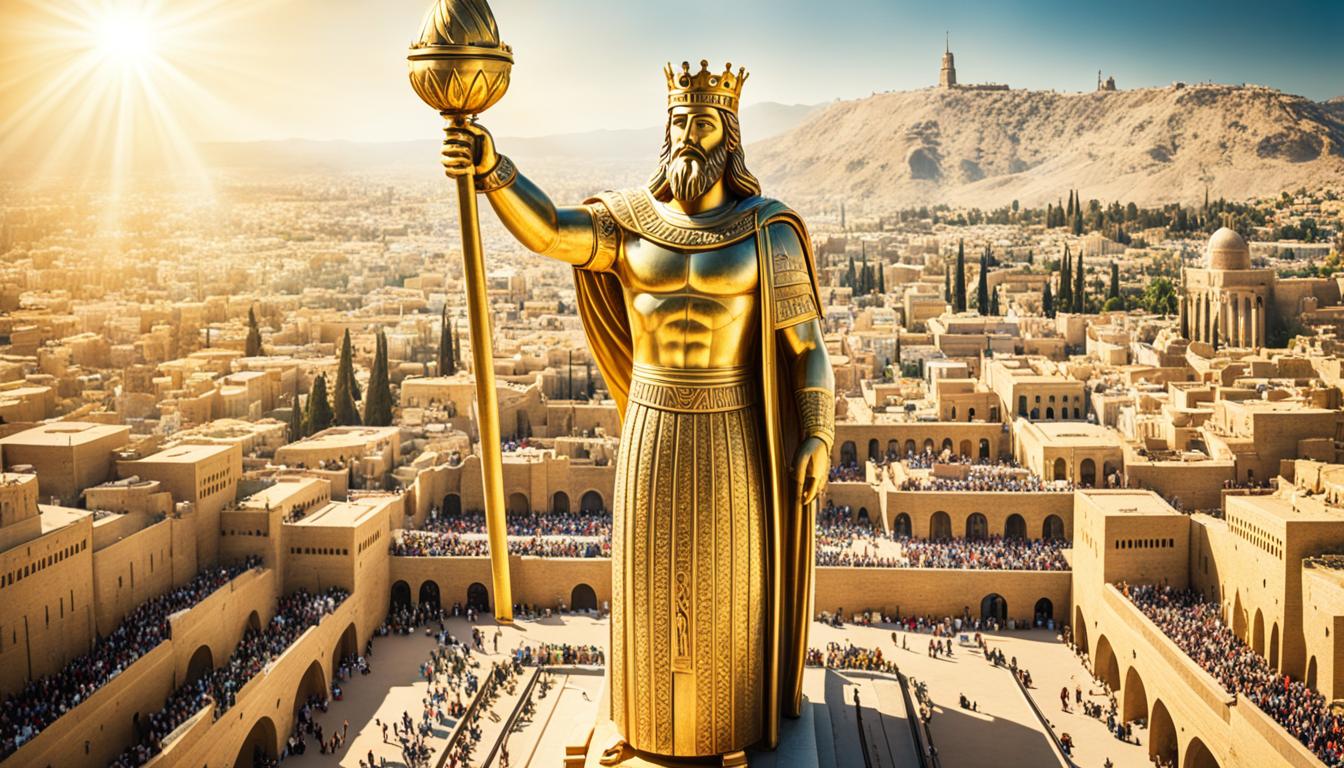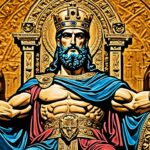King Nebuchadnezzar II, a prominent figure in the Bible, is known for his reign as the ruler of the Neo-Babylonian Empire. His story unfolds in the Book of Daniel, which sheds light on his accomplishments, dreams, and interpretation, as well as his building projects that left a lasting impact on the city of Babylon.
One of the most intriguing aspects of King Nebuchadnezzar’s narrative is his dreams and their interpretation. The Book of Daniel recounts his first dream, featuring a colossal statue representing various empires. Through the interpretation of Daniel, the dream is revealed to symbolize the rise and fall of these kingdoms, with Nebuchadnezzar’s Babylonian empire marked as the head of gold.
Another remarkable dream experienced by Nebuchadnezzar is his second dream, which involved a tall tree being cut down, representing his own downfall and subsequent period of madness. These dreams hold significant religious and prophetic importance, painting a complex picture of Nebuchadnezzar’s relationship with divine messages and his encounter with the Hebrew God.
Despite his achievements and enigmatic dreams, King Nebuchadnezzar’s reign was not without controversy. He is often depicted as an aggressive conqueror, particularly after the destruction of Judah, the homeland of the remaining Jews. Nebuchadnezzar’s treatment of the Israelites, as showcased in the Book of Daniel, paints a complicated picture of his rule, characterized by both kindness towards individuals like Daniel and forced idol worship.
In terms of legacy, Nebuchadnezzar’s building projects stand as a testament to his power and grandeur. His constructions, including the impressive Etemenanki ziggurat and Esagila temple, not only enhanced the city of Babylon but also solidified his position as one of the greatest Babylonian kings in history.
Key Takeaways:3>
- King Nebuchadnezzar II played a significant role in the Bible, particularly in the Book of Daniel.
- His dreams, such as the interpretation of the colossal statue and the tall tree, hold religious and prophetic importance.
- Nebuchadnezzar’s reign was marked by conquests, including the destruction of Judah.
- His building projects, such as the Etemenanki ziggurat and Esagila temple, showcased his power and left a lasting impact on Babylon.
- His complex legacy portrays him as both a powerful ruler and one with questionable actions.
Nebuchadnezzar’s Aggression and Conquests
King Nebuchadnezzar II, the Babylonian king and ruler of the Neo-Babylonian Empire, was known for his aggressive expansionist policies. His reign, as depicted in the Book of Daniel, highlights his conquests and military campaigns, including the subjugation of various nations.
One significant conquest was that of Judah, the homeland of the Jews. Nebuchadnezzar’s forces captured Jerusalem and destroyed the First Temple, resulting in the exile of many Jews to Babylon. This event marked a crucial turning point in Hebrew history and had far-reaching consequences.
“Then the king of Babylon made Mattaniah, Jehoiachin’s uncle, king in his place, and changed his name to Zedekiah.”
The Book of Daniel provides important insights into Nebuchadnezzar’s reign and the impact of his conquests on the Babylonian Empire. While the historical accuracy of certain details may be disputed, it remains a significant source for understanding the extent of his aggression and domination.
The Babylonian Empire
The Babylonian Empire, under Nebuchadnezzar’s rule, expanded to encompass vast territories in the Middle East. Nebuchadnezzar’s conquests included not only the subjugation of Judah but also other prominent nations such as Assyria and Egypt, solidifying Babylonian dominance in the region.
These conquests allowed Nebuchadnezzar to amass immense wealth and power for the Babylonian Empire. The spoils of war, including the plundered treasures of conquered nations, contributed to the grandeur of Babylon as a center of culture, art, and commerce.
Nebuchadnezzar’s Military Strategy
Nebuchadnezzar’s military achievements were not solely reliant on brute force. He employed strategic planning, siege warfare tactics, and the use of advanced weaponry to overcome fortified cities and opposition.
The Babylonian king made significant investments in his military infrastructure, including the construction of powerful siege engines and advanced siege towers. These innovations allowed his forces to effectively breach the walls of enemy cities, leading to swift conquests.
Despite the magnificence of his conquests, Nebuchadnezzar’s rule was not without resistance. The Babylonian Empire faced numerous challenges and rebellions from within and neighboring regions throughout his reign, as is often the case with imperial powers.
Nevertheless, Nebuchadnezzar’s relentless aggression and military triumphs shaped the course of the Babylonian Empire and left a lasting impact on the ancient world.
Nebuchadnezzar’s Dreams and Interpretations
In the Book of Daniel, King Nebuchadnezzar experienced two significant dreams that were later interpreted by the prophet Daniel. These dreams provided insights into the divine messages and Nebuchadnezzar’s interaction with the Hebrew God.
The first dream that Nebuchadnezzar had involved a colossal statue made of different metals, symbolizing various kingdoms and their eventual decline. The interpretation, as revealed by Daniel, attributed the head of gold to Nebuchadnezzar’s own empire. This dream highlighted the significance of Nebuchadnezzar’s reign and his position as a major world power.
“You saw, O king, and behold, a great image. This image, mighty and of exceeding brightness, stood before you, and its appearance was frightening. The head of this image was of fine gold, its chest and arms of silver, its middle and thighs of bronze, its legs of iron, its feet partly of iron and partly of clay.” – Daniel 2:31-33
Nebuchadnezzar’s second dream was that of a tall tree that grew and provided shelter for all creatures but was eventually cut down, representing his fall and subsequent period of madness. This dream foreshadowed the challenges and struggles that Nebuchadnezzar would face and further emphasized the importance of divine intervention in his life.
The dream interpretations given by Daniel showcased Nebuchadnezzar’s belief in divine messages and his recognition of the Hebrew God as a higher power. These dreams played a crucial role in shaping his understanding of destiny and the role he played in history.

These dreams and their interpretations provide valuable insights into Nebuchadnezzar’s reign and his interactions with the divine. They offer a glimpse into the complex nature of his rule and the significance of his impact on biblical history.
Nebuchadnezzar’s Building Projects and Legacy
Nebuchadnezzar II, the notable Babylonian king, etched his name in history through his remarkable building projects. His reign was characterized by an unwavering commitment to city development, architecture, and infrastructure. The city of Babylon served as the canvas for Nebuchadnezzar’s grand vision, where he constructed awe-inspiring structures that showcased the power and grandeur of the Babylonian Empire.
One of Nebuchadnezzar’s most iconic creations was the central ziggurat known as Etemenanki. This monumental tower stood at the heart of Babylon, reaching for the heavens and serving as a symbol of the empire’s dominance. Rising majestically above the city, Etemenanki was a testament to Nebuchadnezzar’s architectural prowess and his desire to create structures that would inspire awe for generations to come.
An equally magnificent building project was the Marduk temple, Esagila. Dedicated to the chief god of Babylon, this temple was an architectural marvel that exuded opulence and religious significance. The interiors of Esagila housed impressive decorations and artworks, showcasing Nebuchadnezzar’s commitment to honoring divine entities and cementing Babylon’s status as a religious center.
These building projects left an indelible mark on the landscape of Babylon and beyond. They stand as a testament to Nebuchadnezzar’s accomplishments and the power and influence of the Babylonian Empire. Even today, remnants of these grand structures continue to inspire awe and admiration for the ancient city’s glorious past.

The impact of Nebuchadnezzar’s building projects
| Building Project | Description |
|---|---|
| Etemenanki | A central ziggurat that symbolized Nebuchadnezzar’s grand vision and the power of the Babylonian Empire. |
| Esagila | A magnificent temple dedicated to the chief god of Babylon, showcasing opulence and religious significance. |
These building projects contributed to Babylon’s reputation as a center of cultural and architectural excellence, solidifying Nebuchadnezzar’s position as one of the greatest Babylonian kings in history. His achievements in city development and architecture are a testament to his ambition, vision, and commitment to showcasing the grandeur of his empire.
Conclusion
King Nebuchadnezzar’s biblical legacy is multifaceted, encompassing both positive and negative aspects. Throughout his reign, he was depicted as an aggressive conqueror with questionable actions. However, his significance in the interpretations of dreams and prophecies demonstrates his connection to the Hebrew God.
Moreover, Nebuchadnezzar’s accomplishments in city development, architecture, and infrastructure have lasting impacts. His grand building projects, such as the Etemenanki ziggurat and the Esagila temple, showcased the power and grandeur of the Babylonian Empire. These achievements solidify Nebuchadnezzar’s position as one of the greatest kings in Babylonian history.
In summary, King Nebuchadnezzar’s biblical legacy presents a powerful ruler with a complex and influential reign. His aggressive conquests, combined with his role in dream interpretations, highlight the intricacies of his character. Additionally, his impressive building projects further emphasize his accomplishments and the enduring legacy he left behind in the city of Babylon.







